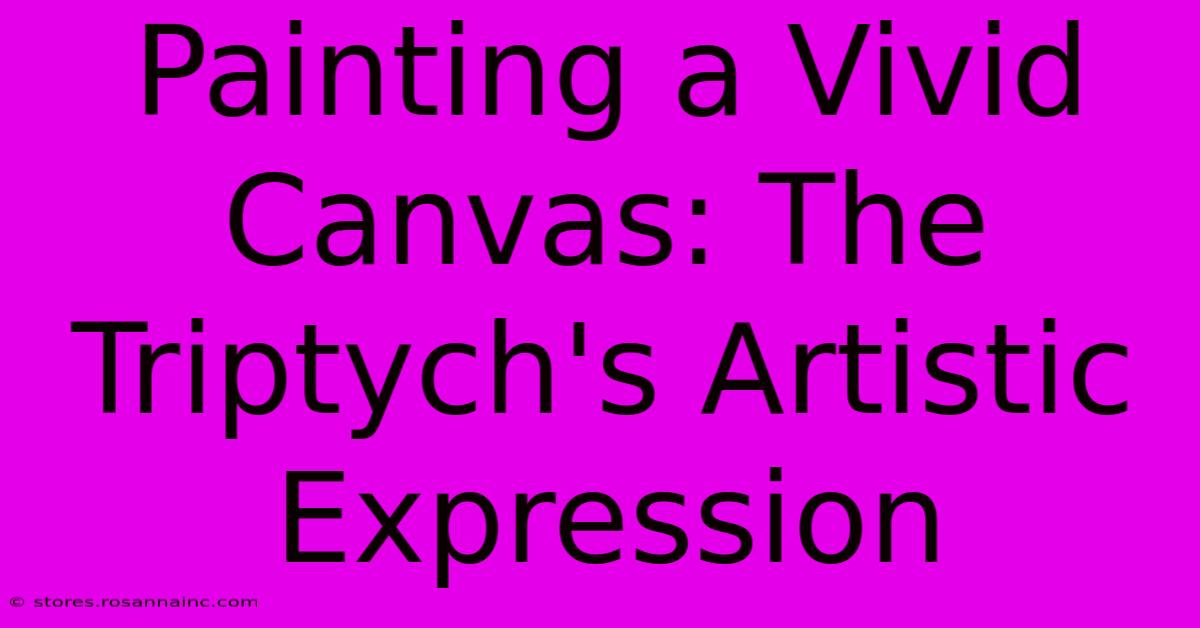Painting A Vivid Canvas: The Triptych's Artistic Expression

Table of Contents
Painting a Vivid Canvas: The Triptych's Artistic Expression
The triptych, a captivating artistic form consisting of three panels, offers a unique canvas for expressing complex narratives, emotions, and spiritual journeys. From religious iconography to modern abstract interpretations, the triptych's power lies in its ability to present a multifaceted story, guiding the viewer's eye through a carefully orchestrated sequence of images. This exploration delves into the artistic expression found within the triptych, examining its historical significance and contemporary relevance.
A History Steeped in Symbolism
The triptych's origins trace back to medieval Europe, predominantly used for religious altarpiece construction. These early examples, often adorned with gilded frames and vibrant religious iconography, served as focal points within churches, narrating biblical stories and celebrating saints. The central panel typically depicted the primary subject, while the side panels offered supplementary scenes or figures, creating a layered narrative. This structure allowed for a rich visual storytelling, making complex theological concepts accessible to a largely illiterate populace.
Notable Examples of Early Triptychs:
- The Ghent Altarpiece (The Adoration of the Mystic Lamb): Jan van Eyck's masterpiece is a prime example of early Flemish painting, showcasing incredible detail and symbolic richness.
- The Mérode Altarpiece: An anonymous artist's work, this triptych offers a glimpse into the domestic life of the wealthy, blending religious themes with everyday scenes.
The use of triptychs extended beyond religious contexts. Renaissance artists like Hieronymus Bosch used the format to explore fantastical and allegorical themes, creating works that are as intellectually stimulating as they are visually arresting. The ability to juxtapose contrasting elements within a single artwork solidified the triptych's position as a powerful tool for artistic expression.
The Triptych in Modern and Contemporary Art
The triptych's enduring appeal is evidenced by its continued use in contemporary art. Modern and contemporary artists have embraced the format, reinterpreting its traditional structure to explore a wide range of themes and styles. Instead of solely religious subjects, artists now utilize the three panels to explore:
- Psychological landscapes: The individual panels might represent different facets of a personality, or stages in a personal journey.
- Social commentary: A triptych can effectively convey a multifaceted social issue by presenting different perspectives or consequences.
- Abstract expression: The triptych lends itself beautifully to abstract works, allowing for the exploration of color, texture, and form across a unified composition.
Exploring Contemporary Triptych Artists:
Researching contemporary artists who continue to employ the triptych format reveals a fascinating array of styles and interpretations. Looking at their work provides insight into the enduring appeal and versatility of this unique artistic format. Consider searching for artists who work with mixed media or collage techniques within the triptych structure, for example.
The Power of Three: Composition and Narrative
The effectiveness of a triptych lies not just in its subject matter, but also in its careful composition. The arrangement of images across the three panels is crucial. Several strategies are commonly employed:
- Central focus: The central panel often dominates, providing the main narrative focus, while the side panels offer context or supporting details.
- Narrative sequence: The panels can unfold a story chronologically, guiding the viewer's eye through a sequence of events.
- Juxtaposition: Contrasting images or themes can be placed side-by-side to create tension and encourage reflection.
The interplay of light and shadow, color palettes, and artistic techniques all contribute to the overall impact of the triptych. The artist's skillful manipulation of these elements can transform the three separate panels into a unified and compelling whole.
Conclusion: A Timeless Artistic Legacy
From its origins in medieval religious art to its contemporary reimagining, the triptych remains a powerful and versatile artistic form. Its ability to weave narratives, explore complex themes, and engage the viewer on multiple levels ensures its enduring appeal. By understanding its historical context and observing its contemporary expressions, we can fully appreciate the artistic richness and expressive potential of this unique and captivating format. The triptych continues to serve as a testament to the enduring power of art to communicate, provoke, and inspire.

Thank you for visiting our website wich cover about Painting A Vivid Canvas: The Triptych's Artistic Expression. We hope the information provided has been useful to you. Feel free to contact us if you have any questions or need further assistance. See you next time and dont miss to bookmark.
Featured Posts
-
Gerberas White Wonder Discover Natures Gift Of Purity And Timeless Grace
Feb 06, 2025
-
Thank You Prompt Response Uncovering The Secrets Of Lightning Fast Service
Feb 06, 2025
-
Beyond The Lens The Secrets Of Black And White Photography Revealed
Feb 06, 2025
-
A Beacon Of Gynecological Expertise Illuminating The Path To Optimal Womens Health
Feb 06, 2025
-
Unleash Your Inner Bard D And D Nails That Sing Of Adventure And Creativity
Feb 06, 2025
